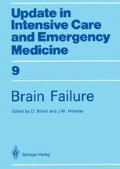Abstract
Whatever the technique used for ventilatory support, positive pressure breathing (PPB) elevates intrathoracic pressure. Local circulations can be altered by different mechanisms acting all together or separately [1]. These mechanisms consist in:
-
1.
a reduction in systemic arterial pressure (SAP);
-
2.
an impairment of local venous return and an increase in venous pressure;
-
3.
an intrinsic or extrinsic modification of local vasoactive status.
Access this chapter
Tax calculation will be finalised at checkout
Purchases are for personal use only
Preview
Unable to display preview. Download preview PDF.
References
Payen DM, Beloucif S (1987) Circulatory effects of mechanical ventilation. In: Vincent JL, Suter PM (eds) Update in intensive care and emergency medicine, vol 2. Springer, Berlin Heidelberg New York Tokyo, pp 135–145
Auer LM, Loew F (eds) (1983) The cerebral veins. An experimental and clinical update. Springer, Berlin Heidelberg New York Tokyo, pp 3–38
Luce JM, Huseby JS, Kirk W, Butler J (1982) A Starling resistor regulates cerebral venous outflow in dogs. J Appl Physiol 53:1496–1503
Wagner EM, Traystman RJ (1983) Cerebral venous outflow and arterial microsphere flow with elevated venous pressure. Am J Physiol 244:H505–H512
Wei EP, Kontos HA (1982) Responses of cerebral arterioles to increased venous pressure. Am J Physiol 243:H442–H447
Doblar DD, Santiage TV, Kahn AU, Edelman NH (1981) The effect of positive end-expiratory pressure ventilation (PEEP) on cerebral blood flow and cerebrospinal fluid pressure in goats. Anesthesiology 55:244–250
Luce JM, Huseby JS, Kirk W, Butler J (1982) Mechanism by which end-expiratory pressure increases cerebrospinal fluid pressure in dogs. J Appl Physiol 52:231–235
Apuzzo MLJ, Weiss MN, Petersons V, Small RB, Kurze T, Heiden JS (1977) Effect of positive end-expiratory pressure ventilation on intracranial pressure in man. J Neurosurg 46:227–232
Editor information
Editors and Affiliations
Rights and permissions
Copyright information
© 1989 Springer-Verlag Berlin Heidelberg
About this paper
Cite this paper
Payen, D.M., Lamer, C. (1989). Influence of Mechanical Ventilation on Brain Circulation and Function. In: Bihari, D., Holaday, J.W. (eds) Brain Failure. Update in Intensive Care and Emergency Medicine, vol 9. Springer, Berlin, Heidelberg. https://doi.org/10.1007/978-3-642-83929-0_14
Download citation
DOI: https://doi.org/10.1007/978-3-642-83929-0_14
Publisher Name: Springer, Berlin, Heidelberg
Print ISBN: 978-3-540-51655-2
Online ISBN: 978-3-642-83929-0
eBook Packages: Springer Book Archive

